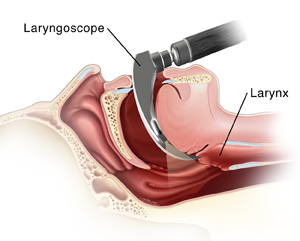Direct Rigid Laryngoscopy
Direct Rigid Laryngoscopy
Direct rigid laryngoscopy is a procedure to look at the vocal cords or larynx. A laryngoscope is a rigid, hollow tube with a light attached. Using this tool, your healthcare provider can look behind your tongue and down your throat to your vocal cords. A tissue sample (biopsy) can be taken for study in a lab. Or a growth can be removed. Your healthcare provider can tell you more about your procedure depending on why it’s being done.

Getting ready for the procedure
Prepare for the procedure as you have been instructed. Be sure to tell your healthcare provider about all medicines you take. This includes over-the-counter medicines. It also includes herbs and other supplements. You may need to stop taking some or all of them before surgery. Your healthcare provider will let you know. Also follow any directions you’re given for not eating or drinking before surgery.
The day of the procedure
The procedure takes 15 to 30 minutes. You will likely go home the same day.
Before the procedure
Here is what to expect before the procedure begins:
-
An IV line is put into a vein in your arm or hand. This line delivers fluids and medicines.
-
You will be given medicine (anesthesia) to keep you pain free during surgery. This may be general anesthesia, which puts you in a state like deep sleep.
During the procedure
Here is what to expect during the procedure:
-
You will lie on your back on a table. You may need to extend your head and straighten your neck to allow the endoscope to pass. Let your healthcare provider know if you have neck problems. The scope is put into your mouth and passed down into the throat.
- If you have dentures, they will be removed for the laryngoscopy.
-
Your healthcare provider examines the larynx and surrounding areas with the scope. If needed, a biopsy is done using small tools put through the scope.
-
If a growth is found, tools can be put through the scope to remove it.
After the procedure
You will be taken to a room to wake up from the anesthesia. At first, your throat may be sore and scratchy. Your voice may be hoarse, making talking difficult. And it may be hard to swallow. You will receive medicine to control pain. When you are released to go home, have an adult family member or friend ready to drive you.
Recovering at home
Once home, follow any instructions you have been given. Be sure to:
-
Take pain medicine as directed.
-
Drink plenty of water as soon as you can swallow normally.
-
Use throat lozenges as advised by your healthcare provider to help ease throat soreness.
-
Rest your voice as instructed by your healthcare provider.
When to call your healthcare provider
After you get home, call your healthcare provider if you have any of the following:
-
Chest pain or trouble breathing (call 911)
-
Fever of 100.4° F ( 38° C) or higher, or as directed by your healthcare provider
-
Problems swallowing that prevent you from eating or drinking
-
Pain that does not go away even after taking pain medicine
-
Severe nausea or vomiting
-
Bloody vomit
-
Cough that brings up blood
Follow-up
Within a few weeks, you will see your healthcare provider for a follow-up visit. During this visit, your provider will discuss the results of the procedure. Depending on what was found you may need further evaluation and treatment.
Risks and possible complications
The risks of this procedure include:
-
Bleeding
-
Infection
-
Gagging
-
Vomiting
-
Cuts in the mouth or throat
-
Injury to the teeth
-
Vocal cord injury
-
Breathing problems
- Collapsed lung
-
Risks of anesthesia
Updated:
November 21, 2020
Sources:
Collins, S., Direct and Indirect Laryngoscopy: Equipment and Techniques, Respiratory Care (2014); 59(6); 850-864
Reviewed By:
Ashutosh Kacker MD,John Hanrahan MD,Daphne Pierce-Smith RN MSN